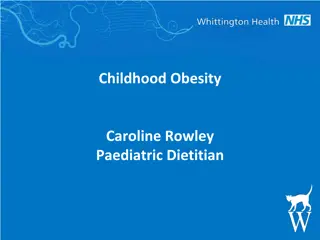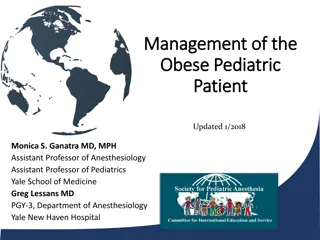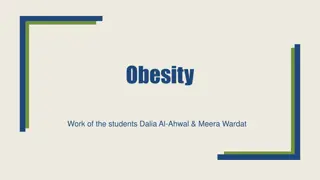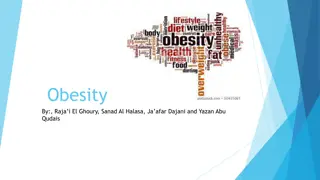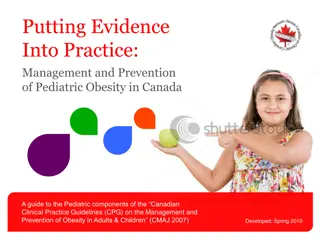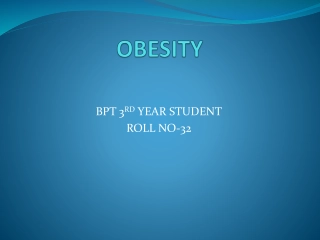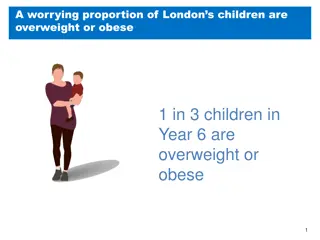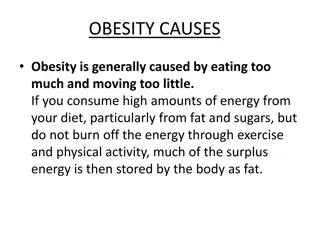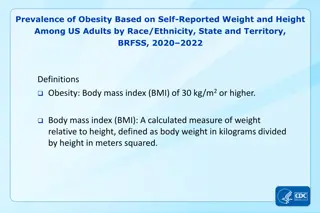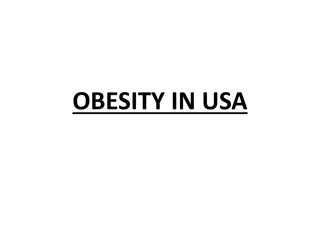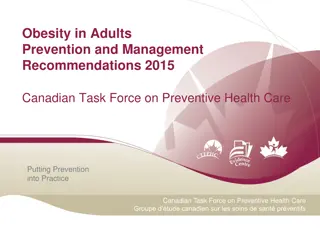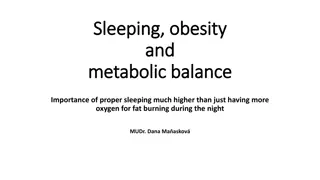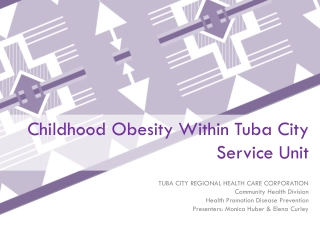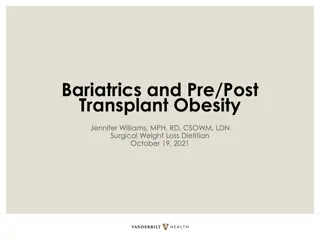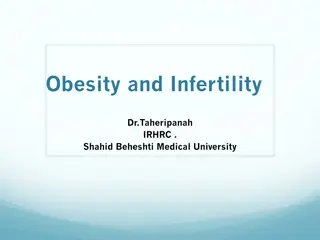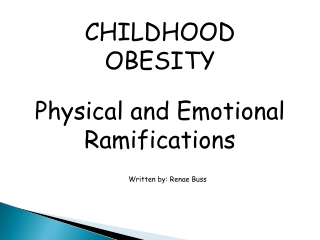Comprehensive Approach to Obesity Management and Prevention
This educational content covers topics such as defining and classifying obesity, discussing the prevalence and common causes of obesity in Saudi Arabia, highlighting prevention strategies, identifying morbid obesity, and exploring evidence-based approaches for weight reduction. It emphasizes the role of exercise, dieting, medication, and bariatric surgery in addressing obesity, as well as the importance of health teams, medical students, and school health programs in managing obesity within the community.
Download Presentation

Please find below an Image/Link to download the presentation.
The content on the website is provided AS IS for your information and personal use only. It may not be sold, licensed, or shared on other websites without obtaining consent from the author. Download presentation by click this link. If you encounter any issues during the download, it is possible that the publisher has removed the file from their server.
E N D
Presentation Transcript
Objectives Define obesity and classify the degree of obesity BMI, Waist circumference and Waist to Hip ratio . Highlight the prevalence of obesity in Saudi Arabia. Discuss how to prevent obesity in the community. Discuss the common causes of obesity in the community. Morbidity common health problems due to obesity Discuss the evidence based approach to decrease weight Exercise, Dieting, Drug treatment, and Bariatric Surgical Intervention . Role of health team, medical students and school health in dealing with obesity in the community
Quiz What is the cause of Obesity? A. Unhealthy diet. B. Genetics. C. Low physical activity. D. All of the above.
Quiz Which of the following records considered as morbid obesity? A. BMI of 26.9 kg/m2 B. BMI of 34 kg/m2 C. BMI of 41.5 kg/m2 D. BMI 39.7 kg/m2
Quiz Which of the not considered a secondary approach? A. Surgery B. Exercise C. Medication D. Self induced vomiting
Obesity Excessive fat accumulation in the body and major risk factor for many chronic illness
How to measure it You can use: BMI Waist circumference Waist to hip ratio
BMI The best measure of obesity is body mass index (BMI). BMI = (weight in kg (height in m)2) Class III = Morbid obesity
Waist Circumference An alternative measure. Halfway between the superior iliac crest and the rib cage. Used in addition to BMI to aid assessment of health risks. If you are a woman: your risk is increased at 80 cm or more your risk is high at 88 cm or more If you are a man: your risk is increased at 94 cm or more your risk is high at 102 cm or more For every 1 cm increase in waist circumference, the RR of a CVD event increase by 72%.
Waist to Hip ratio This is calculated as waist measurement divided by hip measurement (W/H). For example, a person with a 25" waist and 38" hips has a waist-hip ratio of about 0.66. Out of the previous methods of classifications of obesity, waist- hip ratio was found to have the strongest correlation with total and cardiovascular disease mortality
Males The prevalence in KSA According to WHO , the prevalence in KSA is 24% male , 36% female. Females Another study done in KSA 2014 : Male 24% Female 33.5%
Causes of Obesity Genetics Multiple factors including genetic makeup, environment and behavior can cause weight gain and obesity which can lead to progressive weight gain including unsuccessful weight loss despite effort with diet and exercise
Causes of Obesity Most common causes according to MOH are as following: 6. 7. 8. 9. 10. some diseases like: Cushing's syndrome, hypothyroidism and other medical conditions which leads difficulties in daily activities like osteoarthritis. Low education Aging or being older Marital status Pregnancy 1. 2. 3. 4. 5. family history Diet or food style either for individual or families Sedentary lifestyle. Some medications such as: TCAs. Sleep disturbance
Obesity Comorbidities DM : T2DM Dyslipidemia : Reduction in serum (HDL) cholesterol of about 5%. Heart diseases: 1. Coronary disease. 2. Heart failure. 3. MI. 4. Atrial fibrillation/flutter. Skin changes: 1. Stretch marks (striae) 2. Acanthosis nigricans. 3. Hirsutism.
Obesity Comorbidities Colon CA. Gallstones. Sleep apnea. Gout and gouty arthritis. Osteoarthritis Knee Psychological complications suicide
Obesity Comorbidities
Primary Prevention 1. Focusing on healthy lifestyle behaviors related to maintaining normal weight. Healthy diet contains: Fruits, vegetables, legumes (e.g. lentils, beans), nuts and whole grains. Less than 10% of total energy intake from free sugars. Less than 30% of total energy intake from fats. Unsaturated fats (e.g. found in fish, nuts) are preferable to saturated fats (e.g. found in fatty meat, butter, cheese). Industrial trans fats (found in processed food, fast food, snack, frozen pizza) are not part of a healthy diet. Less than 5 g of salt/day and use iodized salt.
Primary Prevention 2. Exercising and active life style: Walk and exercise for 30 minute or more, 5 days a week. Get enough sleep at night. Cessation of smoking. Avoid social and psychological stresses. 3. Long term observation for what you eat and drink.
5-2-1-0 message Encourage intake of daily 5 rations of fruits and vegetables Include at least 1 hour or more of active play every day 5 1 2 0 Encourage eating with the child in a sociable atmosphere , separate eating from other activities and keep recreational screen time to <2 hour Skip sugar-sweetened beverages and drink more water every day
Primary Prevention For children : Change family eating habits and activity levels. Reduce time spent in front of TV , computer and mobiles. Avoid using food as a reward.
Assessing Weight History Age of onset Family history Any history or symptoms of eating disorder (binge eating) Unhealthy weight loss (misuse of laxatives, self-induced vomiting) Is weight stable and for how long What have been the maximum and minimum weight Any attempt to lose weight what was it and did it work If not ask why If yes ask did you maintain Does they understand the triggers Any medication to lose wight Any surgry to lose weight Have they seen a professionals for weight loss
The 5As Approach Ask and assess __ current lifestyle behavior and body mass index, comorbidities and other factors related Advise __ promote the benefits of healthy lifestyle and explain the benefits of weight management Assist __ develop a weight management program that includes lifestyle interventions tailored to the individual and plan for review and monitoring Arrange __ regular follow-up visits, referral as required and support
How to Treat? Surgery Pharmacotherapy Lifestyle Modification
Secondary prevention Exercise: Weight loss is greater in diet plus exercise regimens than in diet-only regimens. Exercise regimens alone, without reduced-calorie diets, are not effective for weight loss. Moderate physical exercise is introduced with 3 sessions per week, 30 minutes per session, then later increased, as tolerated. Example: walking at 3 miles per hour (350 kcal/hour). bicycling on level ground at 10 to 12 miles per hour (600 kcal/hour).
Secondary prevention Dieting: At 6-month follow-up, the low-carbohydrate/high-protein diet has been found to produce greater weight loss than the low-fat diet, and patients seemed to prefer the low-carbohydrate/high-protein diet. Adherence to the diet (i.e., compliance) and the reliability of patient reporting of caloric intake have been problematic in studies on dietary intervention. Reduce consumption of junk food Eat 500 to 1,000 fewer calories each day.
Secondary prevention Psychological/behavioral interventions Psychological interventions should be part of any weight management program. It should be adjusted to circumstances of the individuals or their families.
Secondary prevention Drug treatment: When to use? Orlistat have modest effectiveness (about 5% loss in body weight) when combined with diet and exercise alone, but mild gastrointestinal side effects are common. Failure of diet and exercise BMI > 30 BMI > 27 and associated with medical problems related to obesity
Secondary prevention Drugs: Primary options: Orlistat: Patients usually complained from oily stools and fecal incontinence. Secondary options: Lorcaserin. Liraglutid Naltrexone/bupropion hydrochloride Tertiary options (not preferable): Phentermine.
Secondary prevention 1. Failure of conservative treatment 2. BMI > 40 (morbidly obese) 3. BMI 35 kg/m2 with obesity-related comorbidity (e.g., hypertension, diabetes, sleep apnea, GORD) may be candidates for most bariatric procedures. Indications for surgery: Adjustable Gastric Banding is the most commonly used surgery
Tertiary prevention TREATMENT OF COMPLICATIONS : Slowing the progression to more severe form of obesity Reducing the likelihood of associated musculoskeletal, metabolic, or vascular disorders (e.g., osteoarthritis, diabetes, or cardiovascular disease).
The Health Team The physical activity and eating behaviors that affect weight are influenced by many sectors of society, including families, community organizations, health care providers, faith-based institutions, businesses, government agencies, the media, and schools. The involvement of all of these sectors will be needed to reverse the epidemic.
The Health Team and medical students Health professionals have an important role in promoting preventive measures and encouraging positive lifestyle Behaviors awareness of the population .. Also have a role in counseling patients about safe and effective weight loss and weight maintenance programs.
At Schools Schools cannot solve the obesity epidemic on their own as well . School can also help address obesity by providing: Screening Health information Referrals to students The Role of Schools in Obesity Prevention: More nutritious food Physical activity Health services. Health education
Quiz What is the cause of Obesity? A. Unhealthy diet. B. Genetics. C. Low physical activity. D. All of the above.
Quiz Which of the following records considered as morbid obesity? A. BMI of 26 kg/m2 B. BMI of 30 kg/m2 C. BMI of 41 kg/m2 D. BMI 38 kg/m2
Quiz Which of the not considered a secondary approach? A. Surgery B. Exercise C. Medication D. Self induced vomiting
Our Massage The best measure of obesity is body mass index (BMI). The prevalence in KSA is high among both genders. Obesity is a multifactorial condition Genetic, environment and behavior . Obesity is associated with comorbidities DM,HTN..etc . The prevention and management start by diet and physical activity. The involvement of all of society sectors will be needed to reverse the epidemic.
References Oxford handbook of general practice Obesity Saudi Guidelines : http://www.saudijobesity.com/article.asp?issn=2347- 2618;year=2013;volume=1;issue=1;spage=18;epage=30;aulast=Al- Shehri http://bestpractice.bmj.com/best- practice/monograph/211/treatment/details.html#expsec-5 https://www.ncbi.nlm.nih.gov/pmc/articles/PMC4193060/ WHO website




